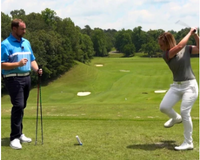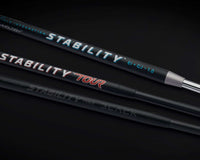Many players pick a putter by the looks; typically shape of the head. Or by reading the marketing on the latest "forgiving putters". We find that this method usually doesn't identify the best putter for the player's stroke or even aim!
Let's start with the basics of fitting a putter.
-
Aim
-
Length & Head design/weight
-
Lie, Loft, Grip
Step One:
We start with aim. If you can't aim the ball or putter head properly, the head design, MOI or anything else won't matter. Using a Visio Laser and Visio Aimboard, we independently assess your ability to align the ball and your putter face to the target line. This will dictate your posture and is specific to you.

Step Two:
Shaft length is directly dependent on the what was identified in Step One : Aim. Once we know that you are able to aim properly we can identify the shaft length and preferred head design. Often the lines/dots on the putter and the position of those can influence your aim - so we might use that input to try a different head.
Shaft length is entirely dependent upon a players posture/setup and the position that they need to be in to see the the line to a target. It used to be that getting a players eyes just over/inside the ball at setup was the preferred way to establish the setup. This method while a good starting point, for some, is a little different for intermediate or advanced players. We like to identify the distance based on the players perception of straight line and then their most comfortable setup in that position. It's a bit of balance between these two. If you don't see the putt line as straight during your setup, you haven't been properly fit for a putter.
After that we look at the head design that best suits a players stroke type. We use the Capto Putting system. This device allows us to "zero-in" on every aspect of the putting stroke. An important aspect to pay attention to is 'Face Rotation'. It is affected by the position of the hosel, toe hang & head shape. For a player struggling with large variation in face rotation, we look at utilizing mallet type of putter head. Blade design for players who do not close the head efficiently.

We also look at how the head design influences aim. Alignment marks, color, head shape & design also affect the ability of a player to aim properly.
Advanced: Face materials - insert vs. milled. If someone is more or less aggressive putter face can have a big impact on the ball speed consistency. We see lots of people that should be using milled faces and are using "hot" insert faces.

Using inserts that are too soft - if you suffer with distance control this might be contributing to your issues!
Step 3:
Lie angle will predominantly be influenced by the setup and helps control start direction. In our shop we can adjust any putter quickly to match the lie you require and then test. The taller or closer one stands or higher hands, the higher the lie angle might be. It just depends on setup.

Loft is really dependent on the vertical angle of the putter at impact (some might call this angle of attack) AND the speed of greens that the player most often plays. Standard loft of most putters is around 3° but this assumes that the player actually delivers this at impact. Capto gives us this information and allows us to dial in exactly the right amount of loft that's needed. For fast greens (>11), you might need a little less loft and slower greens (<9) you might need a little more. We see lots of "out of spec" putters! At a recent event nearly 60% of the players had putters with lofts that were too low. This is a major factor in distance control! One up and coming putter company (SIK Putters) uses a variable loft based on the point of face impact to help deliver the the right loft at impact - really cool! (More on this later)
PutterGrips are something that attract a lot of discussion with players and coaches. If someone has lots of hand rotation/action, a larger grip OR more weight in the grip end will be a big help. Capto does measure this aspect for us so we can really eliminate other factors! But we do have to look at the grip type someone uses (e.g. left hand low, claw, standard, etc.) Grips can have different tapers and diameters that can help with each of these styles of holding a putter.

After we do this, it really comes down to the players perspective on feel, sound, brand, and colour/finish. We have some players the love the SIK Putters or the variety of Bettinardi milled faces or the Callaway & Taylormade inserts. Click vs. a pop or white line vs. black line! But if we've done a good job of identifying the length, head design, lie, loft and grip we want to get input from the player on the rest!
Not everyone can hit the ball 300 yards, but everyone can make more 5',10', 15' putts!
**Covid Update**
Can we fit a putter remotely? The answer is partial yes. Based on a few diagnostic drills, we can do a basic assessment of the putter length, head design, alignment marks, lie via a “video fitting”. But to be really upfront, without data attached to it, it’s tough to be as precise as we like. As such, we would want to see you eventually to make any add’l adjustments.
Pre-book your session today!
FIRST 10 PEOPLE TO BOOK WILL GET 10% OFF USE COUPON CODE: CWPUTT










1 comment
Nik
Looks really good!